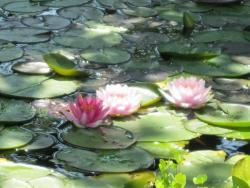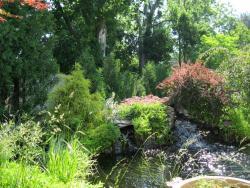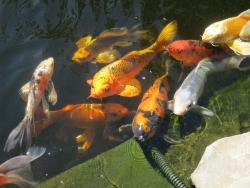A very good way to figure out the size and shape of your pond is to take a garden hose and place it on the ground in an outline, showing the size, shape, and location, to get an idea of how your pond will look when finished. When you have finished moving the garden hose to the way you want your pond to be laid out, take a can of white spray paint and paint the ground around your garden hose. This will give you an outline for digging.
You also have to decide how deep the pond should be. This deeper the pond, the fewer problems you will have with water temperature fluctuations. This is important, as the warmer the pond water is, the less oxygen that water will hold. Conversely, the cooler the pond water, the higher the oxygen content of the water. Also, bear in mind that if you are going to keep koi, they require a larger and deeper pond than goldfish. Plan on about 250 gallons per koi.
Many ponds have shelving built into the sides of the pond. This is a personal preference, but it will also depend on the presence of herons or raccoons. A pond with straight sides, or at least as straight up and down as possible without the dirt falling in, is best if you are in an area that has predators. The straighter sides of the pond will help to keep your fish safe from predators.
After your hole has been dug, use a 2x4 or something that is flat and long enough to span both sides of the pond. Place a level on this board to make sure that your sides are level. All too often, ponds are dug with one side higher than the other. This leaves liner showing on the high side and water spilling over on the low side.
Once you are level, you can start placing the underlayment in the hole. This is imperative to keep rocks, roots, and the like from creating a potential problem with the pond liner.
Many places sell pond liners. The 45 mil EPDM can be pricey, but it is warranted to last for 20 years. The place where you purchase the liner can help with calculating the size of the liner you will need to purchase.
Before putting the liner into the pond, let it sit out in the sun for a couple of hours or so. The sun will help heat the liner and this will make it more pliable. Take care to get as many overlaps and folds as possible out of the liner as you place it into your pond.
Once the liner is in place, you can start to fill your pond. When filling the pond, pay close attention to how much water goes into your pond. It is important to know how many gallons are in the pond, as dosing a pond with any spring start up, enzymes, or fish meds is based on the number of gallons in the pond.
The pond will need pumps that will circulate half the entire volume of the pond in an hour. More is definitely better, as this will enhance the filtration and oxygenation of your pond.
Plants in the pond are a wonderful addition and they will help with water filtration and oxygenation. Plants can be settled on the shelving of the pond. There are a number of different types of plants that have different kinds of requirements. Most of the types of plants that would go on the shelf are referred to as marginals, and it is important to know the correct depth to plant your marginal as all of them have different needs and depth requirements.

If you do not have shelves and have straight sides in your pond instead, you can either place plants along the edging of your pond or you can create a boglike shelf with the plants planted directly into this shelf. This is easily attainable by building a shelf and then blocking off the shelf with rocks so that water can escape through the crevices of the rocks. Pea gravel can be used to fill this bog/shelf area and then the plants can be planted directly into the bog. This will go a long way toward adding extra filtration to your pond. You can also build a bog with plumbing to create a true bog effect, which also will enhance the filtration of your pond.
Waterlilies and lotuses can also be added to a pond. They have depth and lighting requirements for optimal flowering. If your pond is deeper than the requirements for the waterlilies or the lotuses, pots can be inverted at the bottom of the pond to raise the waterlilies and/or lotuses to the correct height.

Many ponds have a gravity-fed bottom drain. This is a matter of personal preference. If you are going to add a bottom drain, it is important to make sure that all of your plumbing is leak proof.
Waterfalls will add another dimension to your pond. A waterfall will attract birds and animals and will help to add oxygen to your pond water. Waterfalls can be built from kits or you can build your own. It is fun to experiment with different designs to find a waterfall with the look and sound that appeal to your taste.

You should now be ready to add fish. Add a few fish at a time. Adding too many fish in a new pond can impact your water quality. Adding a few fish at a time will allow your biological filter to adapt to the fish output and prevent any water quality problems.

When adding fish, place the bag containing the fish into the pond and allow the bag to float for ½ hour. It is important to allow the water temperature in the bag to match the water temperature in the pond. The fish can be released into the pond after the bag has been floating long enough in the pond water.
In the winter, many people cut their plants back and place them on the bottom of the pond. This should help to keep any plant alive for the following season. If you have a bog, then simply cut the plants back so that dead plant material does not end up in the bottom of the pond to decay. Decay could contribute to fish health problems.
In the winter or cooler months, de-icers should be used if the pond is in an area where the pond can freeze over. If you have fish, it is imperative to keep a hole open in the ice to allow gas exchange to occur. If this is not done, the gas buildup under the ice can kill the fish.
For a pond owner (especially in the northern part of the country), it seems a long time between the time to shut down a pond for the winter and the time to start up the pond in the spring. There is no better time in spring for a "ponder" than the time to start up the pond. It does not take long before the waterlilies are shooting up their flat pads, dragonflies start dancing around, and the fish are begging for food as you walk by.
Happy ponding!

| Thread Title | Last Reply | Replies |
|---|---|---|
| Well written article by nicole_martin | Mar 2, 2016 12:22 AM | 0 |
| Great Article by HollyAnnS | Mar 20, 2014 5:23 AM | 4 |